The asparagus is one of the most emblematic products of Navarra, this fertile land is often referred to as the larder of Spain. On the banks of the Ribera del Ebro, with a warm Mediterranean climate and located in a landscape scattered with hills and small mountain ranges, the Autonomous regions of Navarra, Aragon, and La Rioja can be discovered. This area is where the Asparagus of Navarra is cultivated and protected by its Designation of Origin as with many other Spanish gourmet delights from the north such as the Cecina from Leon.
Asparagus is a very contemporary product despite its ancient origins, as proven by Egyptian paintings dating back to 3,000 years BC that show the first images of this vegetable. However, the first time they were actually mentioned was during the Roman Empire in writings by authors such as Pliny.
According to legend, the first seeds of this refined foodstuff were brought from Baghdad in the baggage of a local citizen who was obliged to leave the city and ended up settling in Cordoba. A man from Tudela, who was travelling in those parts, tasted the delicacy for the first time and asked him to spare a few seeds, sowing them on his return in the capital of the Ribera region and making asparagus one of the leading lights of Navarrese cuisine.

The Asparagus of Navarra is a perennial plant which loses its leaves and trunk during the winter, with a productive life that lasts from six to eight years. It has a very powerful root system composed of main roots which grow horizontally and from which the small secondary roots grow. From a central stump or bulb turions or asparagus grow upwards looking for light.This is the secret: to stop them reaching the light. If the "turions" or stems reach the surface, the frond is formed. On the other hand, if they are harvested before they see daylight, we have white asparagus, if not they would turn green with photosynthesis so the earth is frequently raised to form little hills so that the asparagus never sees daylight until it is ready to eat.
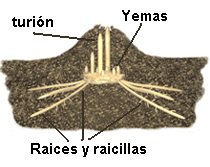
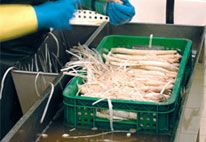
Asparagus is planted during February, placing it at the bottom of a furrow and covering it with sand afterwards. During the spring, the stems grow, and in this period and throughout the summer, the plant accumulates reserves in the roots to be able to sprout the following year. During the winter, the parched frond is cut, and the land is prepared.
In the second year, during March, before the plant begins to sprout again, the ridging is carried out. A ridge is a small pile of earth on the plantation line so that the sprouts reach the surface much later. This provides them with their traditional white colour and makes them much more tender and sweeter
Although the Asparagus from Navarra has traditionally been related to a canned or bottled product, in recent years, strong demand has grown for fresh white asparagus. Fresh white asparagus is available during the harvest-time, which is between April and June. The fresh white asparagus needs to be peeled and normally boiled, a simple process that allows you to enjoy their fuller flavour.
To peel them it is necessary to hold the asparagus by the tender tip and, with a kitchen knife or a vegetable peeler, it must be peeled from top to bottom, being careful not to touch the head, and turning it to homogeneously peel all of it. Lastly, the bottom part of the stalk is cut, and the asparagus is washed in cold water.
To boil them, fill in a deep pan with water and bring it to the boil. As soon as it begins boiling, add three teaspoons of salt and 1 teaspoon of sugar, carefully insert the asparagus piece by piece so as to maintain the temperature. Boil for approximately twenty minutes until they are tender (you should be able to easily spear them with the fork).
Once boiled and drained, it is recommendable to eat them warm, to be able to appreciate their full flavour with a drizzle of extra virgin olive oil. However, this may seem a bit simple for some so at the end of the post I have included three dressing recipes to accompany the asparagus, wonderful recipes for this summer if you fancy a healthy, light and fresh meal which is really simple to make.
Vegetables have, in general, a low-calorie content, but the asparagus is a particularly low-calorie vegetable. It almost has no fats or carbohydrates, and strangely has a strangely high amount of proteins for a vegetable. Its content of dietary fibre is very significant, as is the content of vitamins and minerals.
When mentioning vitamins, one needs to mention the presence of thiamine, riboflavin, niacin, and above all, alfatocoferol. This substance, also known as vitamin E, is one of the natural antioxidants we can find in food. It plays a very important role in the development and maintenance of the central nervous system, peripheral nerves and child and adult muscles. Nowadays, its influence on the cardiovascular risk profile and its inhibiting actions on the growth of leukaemia cells are being investigated. Although we do not have a specific organ to store vitamin E, we have small storage rooms in our liver and in the adipose tissue, with the added advantage that when someone loses weight (loses fat tissue), the amount of vitamin E stored in that tissue remains.
But beside these facts, the asparagus has a very characteristic substance: asparagine, a volatile substance which enhances the diuretic effect of the asparagus, helping with the water retention and hypertension associated with being overweight. It is a food source highly recommendable for:
-
People who need to eat low-calorie food, but which is rich in nutrients, as happens with people who are on a slimming diet
-
People who suffer from constipation, due to the high content of fibre of asparagus.
-
People who suffer from hypertension or water retention.
If they are going to be eaten fresh, they should be boiled with the smallest possible amount of water in order to minimise the loss of vitamins in the water.
The asparagus should not be washed after being peeled, as its water-soluble vitamins can be lost in the water. The stock resulting from the boiling of the asparagus is highly diuretic, which makes its use recommendable for soups, and rice dishes.
So who would have thought that this unusual vegetable would be so good for you and why isn't everyone eating them? Well, we should be and if you find them a bit bland at times here are a few ideas to jazz them up and create a wonderful summery starter or light main meal. Either buy fresh D.O.P Asparagus from Navarra when they are in season, (which at the moment they aren't ) or buy them already cooked in a glass jar or a can, try and find the large thick asparagus (extra grueso) rather than the thin cheaper ones, it makes all the difference.
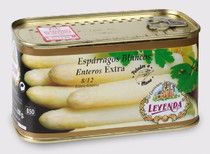
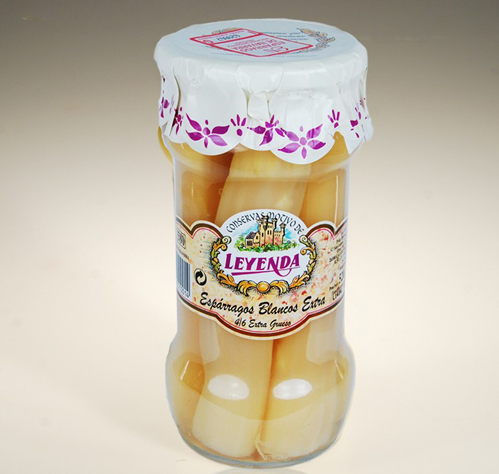
RECIPES WITH WHITE ASPARAGUS
1. Asparagus with Pipirrana
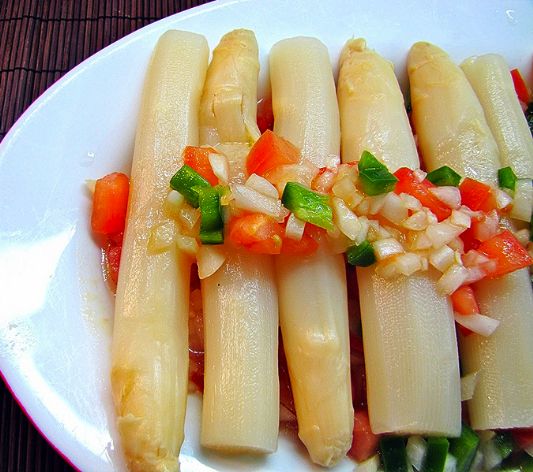
1 large green bell pepper
1 large spring onion
1 large salad tomato
1 small cucumber
Extra Virgin Olive Oil
Sherry Vinegar
1 hard-boiled egg yolk
Salt
Simply finely dice up all the ingredients, put three parts olive oil to one part sherry vinegar and 1/2 part of water into a cup and blend, crush the egg yolk into powder form and then blend into the oil and vinegar, whisk together to form an emulsion, season with salt and pour the vinaigrette over the diced vegetables and leave the Pipirrana to macerate for at least an hour in the fridge. Then simply serve the asparagus cold with the "pipirrana" poured over the top.
TIP: If you want this meal to be slightly more filling add tinned tuna steak to the pipirrana while it is macerating.
2. Asparagus Tropicana

This is similar to the previous Pipirrana but with a tropical fruity twist to it. You will need:
Slices of smoked salmon
1 mature mango
1 large spring onion
1/2 red bell pepper
1/2 yellow bell pepper
1 bunch of fresh chives
Extra Virgin Olive Oil
Sherry Vinegar
Water
Finely dice the mango, the spring onion, the red pepper, the yellow pepper and the chives as in the previous recipe.
Make the vinaigrette as before in a bowl but this time with no egg yolk. Pour the vinaigrette over the diced vegetables and leave for an hour to macerate. Wrap the salmon around the asparagus and place on the plate and then dress the asparagus with the tropical pipirrana.
3. Navarran White Asparagus with Vinaigrette
Ingredients:
1 jar of Navarran white asparagus
2 tablespoons of olive oil
1 tablespoon of vinegar (either white wine or sherry)
1 teaspoon of Dijon mustard
1 shallot, finely diced
Salt and freshly ground black pepper to taste
Chopped parsley for garnish
Instructions:
Prep the Asparagus: Drain the asparagus and pat them dry gently with kitchen paper.
Make the Vinaigrette: In a small bowl, whisk together olive oil, vinegar, Dijon mustard, shallot, salt, and pepper until emulsified.
Assemble: Arrange the asparagus on a serving plate. Drizzle the vinaigrette over the top.
Serve: Garnish with chopped parsley and serve at room temperature or chilled.
4. Cream of White Asparagus Soup
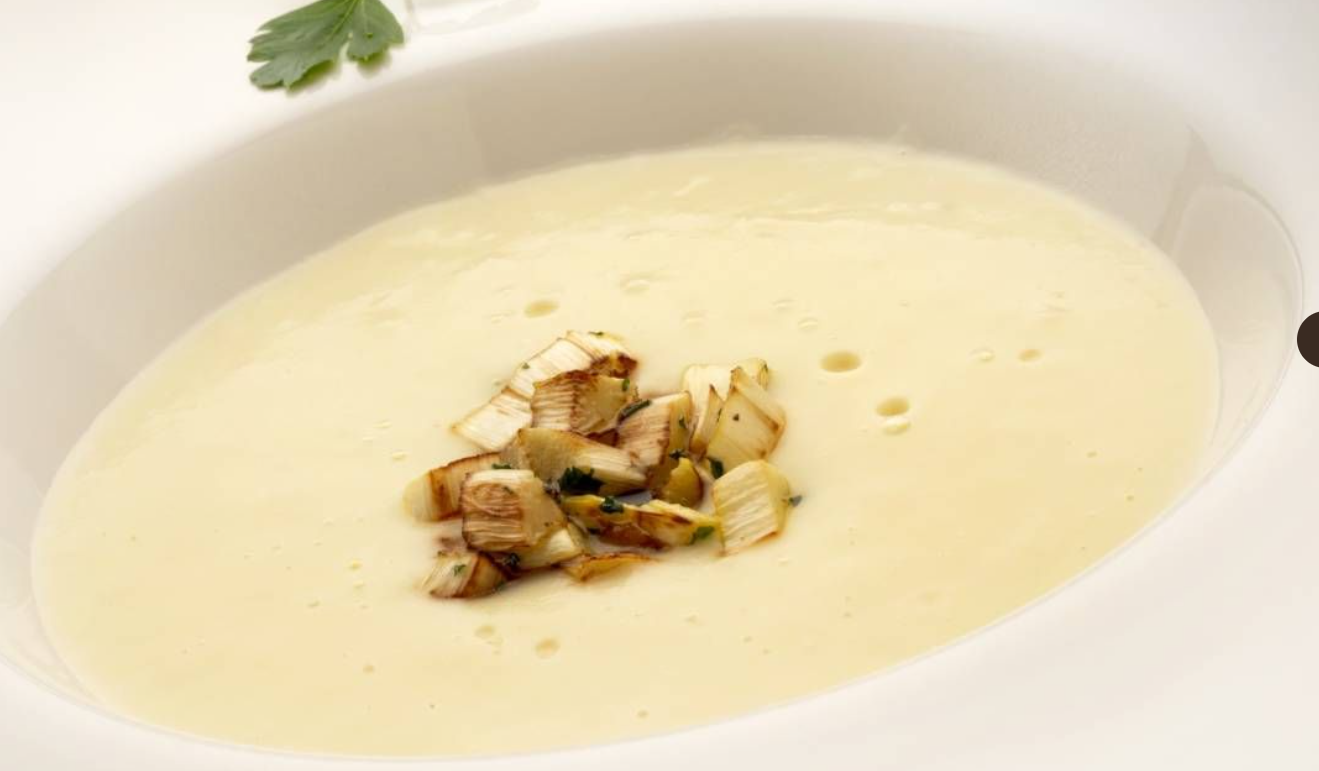
Ingredients:
1 jar of Navarran white asparagus, drained (reserve the liquid)
1 onion, chopped
2 tablespoons of unsalted butter
2 cups of chicken or vegetable broth
1 cup of heavy cream
Salt and white pepper to taste
Chopped chives for garnish
Instructions:
Cook the Onion: In a pot, melt butter over medium heat. Add the onion and cook until soft and translucent.
Add Asparagus: Cut the asparagus spears into small pieces, reserving some tips for garnish. Add the pieces to the pot along with the reserved liquid. Cook for a few minutes.
Add Broth: Pour in the broth. Bring to a simmer and cook for 10 to 15 minutes.
Blend: Using an immersion blender, puree the soup until smooth. Stir in the heavy cream and season with salt and white pepper.
Serve: Heat through, but do not boil. Serve hot or cold, garnished with asparagus tips and chopped chives.
5. Navarran White Asparagus and Ham Rolls
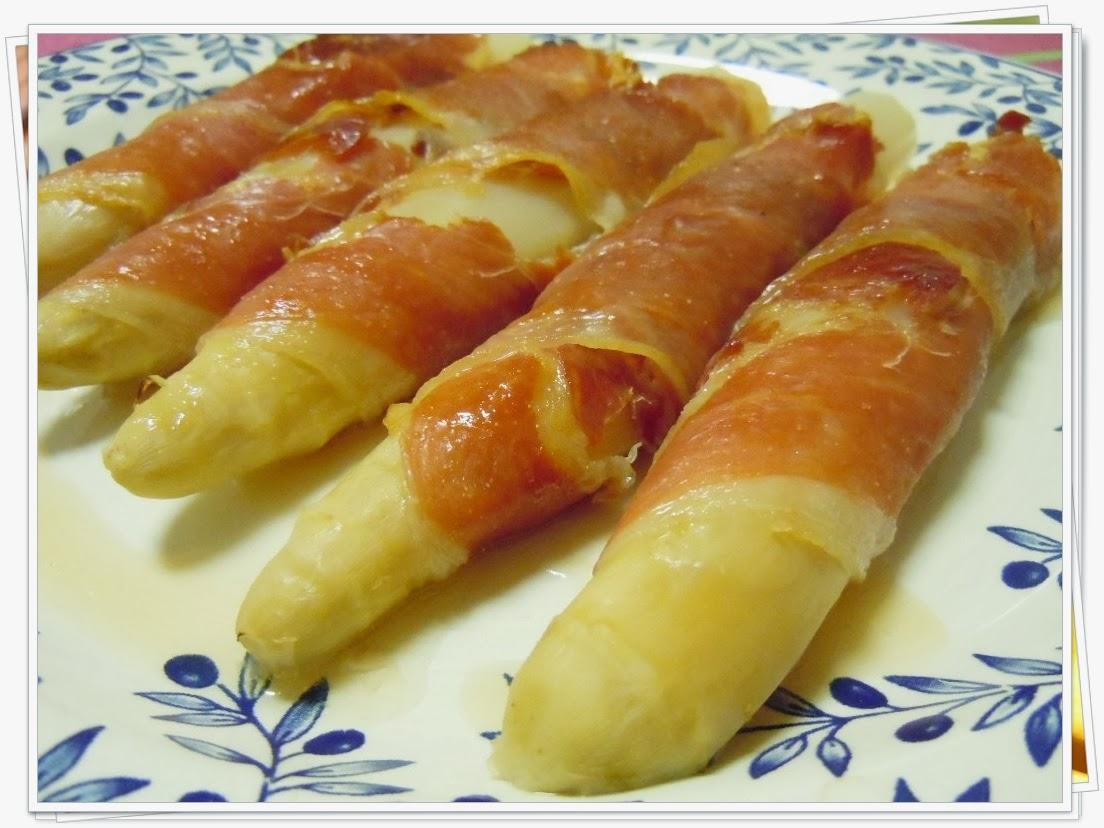
Ingredients:
1 jar of Navarran white asparagus, drained
12 slices of cured ham (such as Serrano or prosciutto)
Olive oil for drizzling
Black pepper to taste
Shaved Manchego cheese (optional)
Instructions:
Prep the Asparagus: Carefully wrap each asparagus spear with a slice of ham.
Cook: In a large skillet, heat a little olive oil over medium heat. Add the rolls and cook until the ham is crisp, turning occasionally.
Serve: Arrange the asparagus and ham rolls on a platter. Drizzle with a little more olive support, sprinkle with black pepper, and, if desired, shave some Manchego cheese over the top.
6. Grilled White Asparagus from Navarra with Hollandaise Sauce
Ingredients:
1 jar of Navarran white asparagus
Olive oil
Salt and pepper
For the Hollandaise Sauce:
3 egg yolks
1 tablespoon water
1 tablespoon lemon juice
1/2 cup (1 stick) unsalted butter, melted
Salt, to taste
Instructions:
Prep the Asparagus: Drain the asparagus and gently pat them dry. Brush them lightly with olive oil and season with salt and pepper.
Grill the Asparagus: Preheat a grill or grill pan over medium heat. Grill the asparagus, turning occasionally until they are warmed through and have grill marks, about 5-7 minutes.
Make the Hollandaise Sauce: In a small heatproof bowl, whisk together egg yolks, water, and lemon juice. Place the bowl over a pot of simmering water (double boiler method), making sure the bottom doesn’t touch the water. Whisk vigorously until the mixture thickens. Slowly drizzle in the melted butter while continuing to whisk until the sauce is thickened and doubled in volume. Remove from heat, season with salt, and keep warm.
Serve: Arrange the grilled asparagus on a plate and drizzle with the Hollandaise sauce.
7. Navarran White Asparagus Risotto
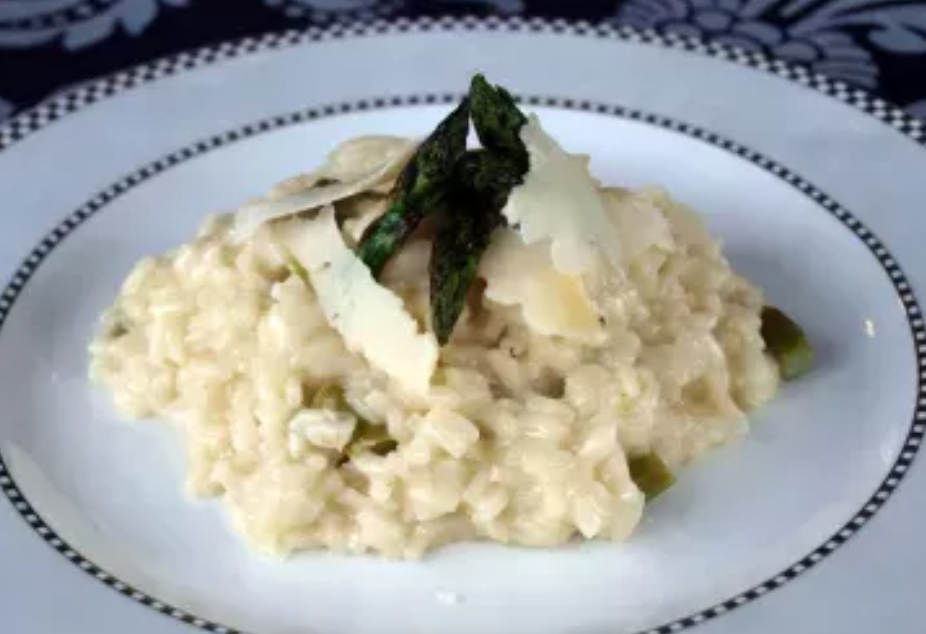
Ingredients:
1 jar of Navarran white asparagus, spears cut into pieces
1 small onion, finely chopped
2 cups Arborio rice
5 cups chicken or vegetable stock, kept warm
1/2 cup white wine
1/2 cup grated Parmesan cheese
2 tablespoons unsalted butter
2 tablespoons olive oil
Salt and pepper to taste
Instructions:
Sauté Onion: In a large pan, heat the olive oil over medium heat. Add the onion and cook until translucent.
Cook the Rice: Add the Arborio rice to the pan. Stir for a couple of minutes until the rice is well coated with the oil and onions. Pour in the white wine and cook until it has evaporated.
Add Stock: Begin adding the warm stock, one ladle at a time, allowing the rice to absorb the liquid before adding more. Continue stirring.
Add Asparagus: When the rice is halfway cooked (about 10 minutes in), add the asparagus pieces. Continue to add stock and stir.
Finish: Once the risotto is creamy and the rice is al dente, remove from heat. Stir in the butter and Parmesan cheese. Season with salt and pepper to taste.
Serve: Serve hot, garnished with extra Parmesan or fresh herbs if desired.
Each of these recipes brings out the delicate, nuanced flavour of the Navarran white asparagus, whether it’s complemented by the rich taste of Hollandaise sauce or integrated into a creamy risotto. Enjoy exploring these different ways to savour this prized ingredient from Navarra.